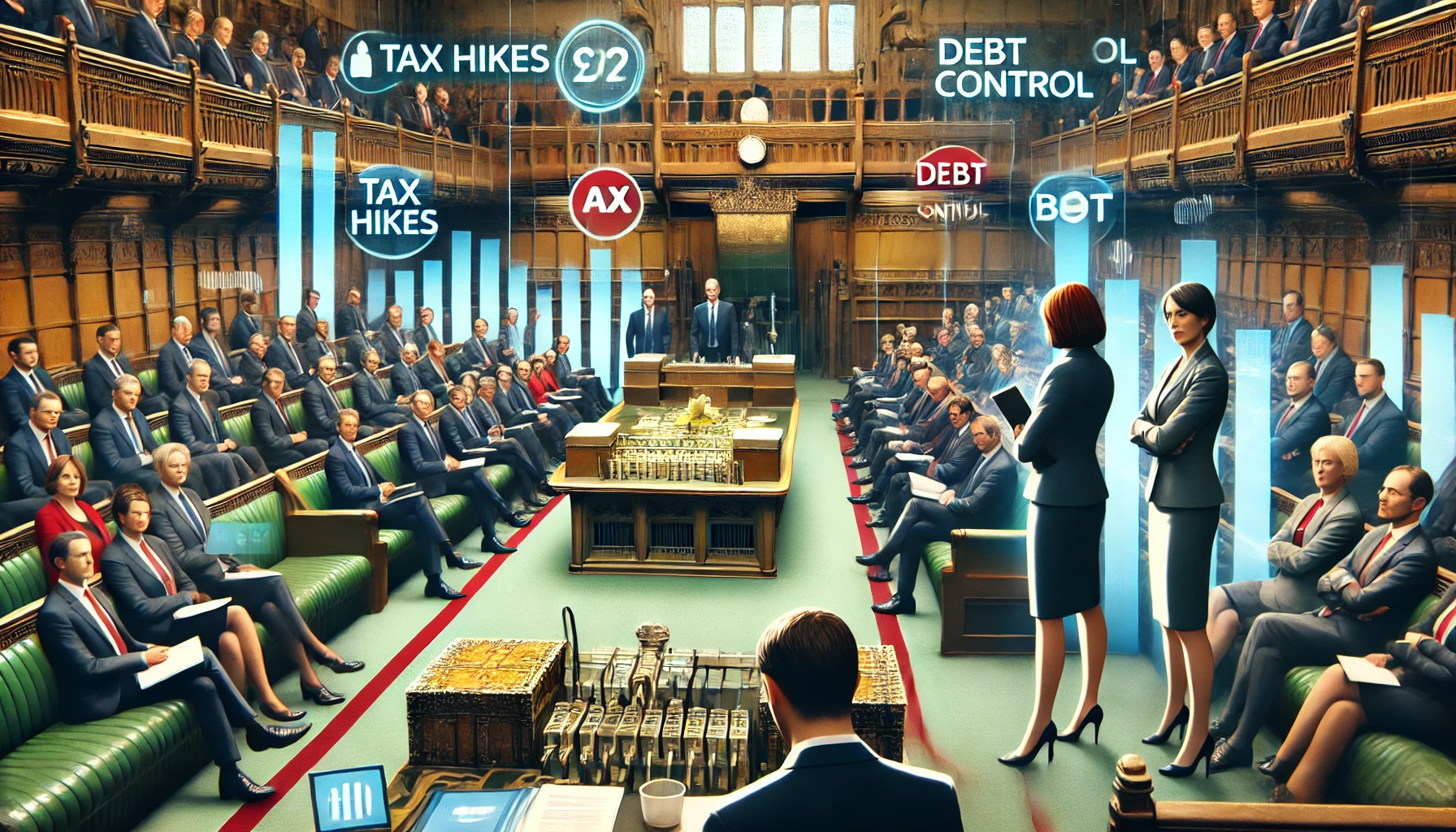UK’s Labour Budget: The 40 Billion Pound “Just Kidding, We’re Not Liz Truss” Moment

Picture this: the UK economy was all set for another round of fiscal chaos, expecting a follow-up performance to the 2022 “Liz Truss Special.” But no, this time, the Labour government decided to go for a different kind of show—one that still had everyone on the edge of their seats, but with fewer nervous breakdowns for investors. Call it a sequel with less drama and more debt control. Chancellor Rachel Reeves, alongside Prime Minister Keir Starmer, unveiled their first budget, and it turns out—spoiler alert—no one threw tomatoes, at least metaphorically. Let’s unpack what went down and why we didn’t end up in a fiscal clown car this time.
A New Twist: Debt Without the Doom
Labour’s budget revealed a 40 billion pound tax hike designed to fill the financial void left behind by its predecessor, which apparently came with a free “black hole” souvenir. Investors braced themselves for a potential face-plant reminiscent of 2022, when Liz Truss nearly sent UK bonds into the abyss with her chaotic mini-budget. But Reeves brought a subtle twist: she balanced ambitious debt and public investment plans with a promise to keep day-to-day spending in check. It’s like she managed to upgrade the nation’s car while promising not to max out the credit card on fuel.
Gilt Yields Rise (But Not Like Last Time)
UK government borrowing costs, measured by 10-year gilt yields, did climb, reaching their highest level since May at around 4.38%. But here’s the kicker—it wasn’t a panic move, more of a cautious, careful ascent compared to the rocket-fueled chaos from two years ago. Investors, who had been harboring fears of another “Liz Truss moment,” breathed a sigh of relief when things remained mostly under control. The domestically-focused FTSE mid-250 index jumped briefly by more than 1.5%, while sterling also rose, as traders collectively unclenched. Edmond de Rothschild’s portfolio manager Nabil Milali summarized it best: “Investors feared chaos, but in the end, the announcements did not suggest an uncontrolled surge in debt.” In other words, the car didn’t veer off the road this time.
Why No One Panicked This Time (Hint: The Budget Was Boring—In a Good Way)
Now, Reeves wasn’t entirely unadventurous. She did announce about 100 billion pounds of capital spending over the next five years, channeling the money into infrastructure and, well, anything other than workers’ pockets. This was a shrewd move—direct the tax grabs at businesses instead of the voters, and you’ve got less pitchfork potential. For anyone wondering why the FTSE 250 index closed higher despite pre-budget jitters, that’s why. It’s all about keeping voters happy and giving just enough to investors so they don’t switch to “full panic mode.” This time, however, the excitement came in the form of a steady hand—a bet on extra public investment, rather than just a cautious rollback.
FTSE Boost: Cheap Stocks, a Slightly Happier Consumer, and a Rate Cut in Sight?
The budget also had analysts wondering about the Bank of England’s next move. The BoE had been eyeing a rate cut as early as November—something that might still be on the table. Markets, however, slightly reduced odds for a November cut, with a “maybe” floating in the air for December. Reeves’ balanced approach didn’t exactly change the odds drastically, but Jason Da Silva from Arbuthnot Latham argued that Labour’s promises of more spending on health and infrastructure could lift weak consumer sentiment—great news for cheap, domestically-focused UK stocks. Or, as Da Silva put it: “That should be good for UK-focused stocks, given they are already cheap.” Because when has any investor ever said no to a bargain?
Debt Rules Rewritten (But Not as Madly)
Here’s where things got interesting—Reeves redefined the whole idea of state indebtedness, changing its measurement to the public sector net financial liabilities (PSNFL). Basically, think of it like adding extra “assets” to make the debt seem less scary. It’s like the fiscal version of pulling out your Pokémon cards and going, “Look, I swear this makes my overall value higher.” Smart? Sure. Shady? Maybe. But if the investors are buying it, who are we to argue?
On a more practical note, Reeves confirmed the plan to increase debt issuance to 296.9 billion pounds from previous estimates of 277.7 billion. Investors had been expecting something like this, so there wasn’t a mad rush for the exits—more of a quick stretch before settling back in to see what else was in store. Marlborough’s James Athey was positive, noting that Reeves had “done a reasonable job of buying credibility with the gilt market,” adding, “Bond markets appreciate revenue boosts from tax hikes when you at least give a good narrative.” Turns out, it’s all about the story you tell.
What It Means for Traders: Hidden Opportunities and Tactical Moves
Forex traders, listen up—this budget might have been a masterclass in avoiding drama, but the opportunities for strategic plays are hidden right beneath the surface. With Labour opting for a growth-focused yet cautious budget, it’s safe to say the pound could see gradual appreciation as investors adjust their risk appetite. Sterling already ticked higher on news of the budget, and that movement may have legs if consumer confidence ticks up.
The gilt market’s tempered response also suggests that investors aren’t running scared anymore. Instead, they’re eyeing specific sectors that could benefit—like homebuilders and retailers. For traders, keeping an eye on these correlated plays might offer a solid play for near-term swing opportunities.
And let’s not forget the big kicker here—the BoE may still opt for a rate cut this year, but it’s far from a sure thing. Playing the pound in a straddle might be a worthwhile consideration for those anticipating further volatility tied to the central bank’s move. In Forex, the magic happens where uncertainty meets opportunity, and there’s plenty of both here.
Less Drama, More Focus on Growth—But with Caution
Labour’s budget managed to calm investor nerves without skimping on bold moves. With a hefty 40 billion pound tax hike, and a focus on business-targeted levies rather than workers, Reeves and Starmer are playing a careful game of balancing austerity fears with growth ambitions. The market reaction, while mixed, didn’t see the pandemonium of 2022. In other words, it’s all about keeping the car on the road while making sure there’s enough gas for the long haul.
For traders, this is all good news. When the markets calm down, strategic opportunities emerge—it’s just a matter of knowing where to look. And lucky for you, we’re all about uncovering those hidden gems and bringing them to light.
So, ready to trade the cautious optimism of a Labour-led UK? Don’t forget to grab your toolkit, including the latest updates on economic indicators, free trading tools, and more—exclusively on StarseedFX.
—————–
Source Inspiration: Reuters
Image Credits: Cover image at the top is AI-generated

Anne Durrell
About the Author
StarseedFX delivers timely Forex news and market insights, thoughtfully edited and curated by Anne Durrell. As a seasoned Forex expert with over 12 years of industry experience, Anne turns complex market shifts into clear, engaging, and easy-to-understand updates.
From decoding the latest trends to writing her own in-depth analyses, Anne ensures every piece is both informative and enjoyable. If you found this article helpful, don’t forget to share it with fellow traders and friends, and leave a comment below—your insights make the conversation even richer! Follow StarseedFX for fresh updates and stay ahead in the dynamic world of Forex trading.






